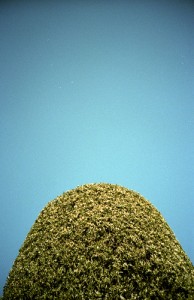Cross Processing, often abbreviated to "XPro", is deliberately processing film in the wrong chemicals. One example of that is processing slide film in the C-41 chemistry normally used for color print negative film and this sometimes results in ultra saturated photographs with wild colors and strong contrast.
During the week, I was reading a post in the LOMO group on Flickr about "post processing" xpro photos and as usual, people were saying they never post process their photos. (I have a separate rant about that subject here  .)
.)
The following cross processed photo was taken on Fuji Sensia 400 and was scanned with an Epson 4490 scan with all of the internal correction turned off.
To me, this "unprocessed" photograph is a little flat. To bump up the contrast, and to give the photo a little more punch I used Photoshop to adjust the levels albeit, ever so slightly. You can see the results here.
To my eye, this is a much better cross processed photograph and this is how I presented it when I first posted the shot in 2006.
But the discussion on Flickr got me thinking about post processing cross processed photographs. Back in the day of optical printing, what you got on the paper was probably a fairly good representation of what was on the negative but with the digital scan/print process that most labs do now, I wondered about all of the "correction" going on.
As a test, I loaded my flat scan into Photoshop and decided to give it auto-levels, auto-contrast and auto-color. The result was completely different than my original scan with the green cast completely removed and the sky rendered a nice blue.
I believe that unless you ask for "no correction", this is what a lot of commercial labs will give you back as prints.
So, is this last example post processed? Absolutely it is and for the analog purists out there I wonder is this what you are getting back from the lab when they hand over your cross processed prints.
Link: "How much post editing do you do?  " - LOMO Flickr group discussion.
" - LOMO Flickr group discussion.


